|
Cover
Story

 SHAMIM
AHSAN SHAMIM
AHSAN
When
a bustling city goes under water, it can lead to the most
unforeseen situations. On July 28 thousands of people gathered
on both sides of the Sayedabad sluice gate. The people of
ward no 84 wanted to open the sluice gate so that their houses,
which are waist to neck-high under water, could have some
respite. The people on the other side of the gate, those of
ward no 86, were getting ready to resist any attempt to open
the gate, because they believed that if the sluice gate was
opened, their area, which was dry till then, would go under
water. Clashes ensued leading to riot police firing tear gas.
Eight to ten people were badly injured. Eventually, however,
nature decided the fate. The pressure of the waters broke
open part of the dam. The misery of living with stagnating
water continues.
Dhaka
looks a different city now -- at least half of it, where roads
are under knee to waist-deep water. The front of every house
or shop in the flood-hit areas now sport six inches to two
feet tall wall to bar the quickly advancing flood water. But
the terribly filthy black water has forced its way into most
of the ground floors in these areas forcing people to raise
their beds or cupboards by placing bricks under their feet.
In many houses the poisonous, noxious water has seeped into
the reserve tanks where water is stored for drinking, cooking,
washing, bathing and other uses. Boats and vans have replaced
rickshaws.
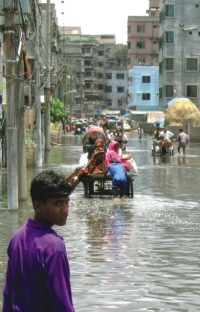 Flood
is, to be sure, one of those natural calamities that cannot
be entirely prevented. But the most disturbing question is
whether we could have done something to prevent the after
effects of the flood from becoming so devastating? We could,
but we didn't. Flood
is, to be sure, one of those natural calamities that cannot
be entirely prevented. But the most disturbing question is
whether we could have done something to prevent the after
effects of the flood from becoming so devastating? We could,
but we didn't.
This
is not of course for the first time that Dhaka has been so
badly affected by floods. Neither is the enormity of the humanitarian
crisis we are witness to for the last few weeks in Dhaka,
unprecedented. In fact, both the major floods in 1988 and
1998 did have more or less similar effects on Dhaka. But in
spite of the bitter experience of the past our policy makers
have remained indifferent to and lethargic about working out
a long-term plan to make sure that the flood waters do not
reach such levels as to paralyse normal life; so that relief
is quick and efficient; and so that water-borne diseases are
controlled and lives are saved. Thus, here comes another flood
and yet again catches us off guard and absolutely unprepared.
Over the years, Dhaka has swelled into an
extremely ill planned and unmanageable city. Dhaka's drainage
and sewerage system are in a bad shape. Though the city's
population has risen sharply over the years, these types of
civic facilities have not been developed to meet the ever-expanding
demand. The result is before us -- even a couple of hours
of rains leave some parts of Dhaka several inches under water
and take hours to recede. Insufficient infrastructural facilities
make floods in Dhaka all the more destructive.
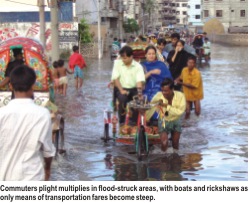 The
general apathy of the citizenry of Dhaka is another reason
for flood waters to stagnate. Selim Bhuiyan, executive engineer
of Flood Forecasting and Warning Centre, says, "Our existing
drainage and sewerage system, which are already inadequate,
are further crippled by the callousness or ignorance of the
city dwellers. They throw away all sorts of wastes in the
drains. The sewerage lines also don't work being forced to
carry sewage many times more than their capacity." In
fact during the last major flood in 1998 the sewerage lines
which were clogged by millions of polythene bags slowed down
the natural flow of the floodwater, delaying the receding
of the flood from Dhaka. The
general apathy of the citizenry of Dhaka is another reason
for flood waters to stagnate. Selim Bhuiyan, executive engineer
of Flood Forecasting and Warning Centre, says, "Our existing
drainage and sewerage system, which are already inadequate,
are further crippled by the callousness or ignorance of the
city dwellers. They throw away all sorts of wastes in the
drains. The sewerage lines also don't work being forced to
carry sewage many times more than their capacity." In
fact during the last major flood in 1998 the sewerage lines
which were clogged by millions of polythene bags slowed down
the natural flow of the floodwater, delaying the receding
of the flood from Dhaka.
 He
then points the lack of foresight of the different government
bodies responsible for developing various facilities in Dhaka.
"Why do we need to widen a drain six inches this year
and then another six inches after two years? Drains have to
be widened on a long term basis, say for the next 20 years,
taking into consideration the possible rise of population
in a particular area during that projected time period,"
he says. "Unless of course the real intention is to make
money by manipulating the public exchequer," he adds
wryly. Besides, our policy makers are only concerned about
raising the road so that water does not accumulate on them.
What they are missing is when the water cannot stand on roads
it will get into houses which have not been raised. After
five years a few hours of rains will see your ground floors
a few inches under water if this practice continues. What
is needed is to widen the drains and keep them open so that
they can be cleaned when needed, so that there isn't any clog,"
he argues. He
then points the lack of foresight of the different government
bodies responsible for developing various facilities in Dhaka.
"Why do we need to widen a drain six inches this year
and then another six inches after two years? Drains have to
be widened on a long term basis, say for the next 20 years,
taking into consideration the possible rise of population
in a particular area during that projected time period,"
he says. "Unless of course the real intention is to make
money by manipulating the public exchequer," he adds
wryly. Besides, our policy makers are only concerned about
raising the road so that water does not accumulate on them.
What they are missing is when the water cannot stand on roads
it will get into houses which have not been raised. After
five years a few hours of rains will see your ground floors
a few inches under water if this practice continues. What
is needed is to widen the drains and keep them open so that
they can be cleaned when needed, so that there isn't any clog,"
he argues.
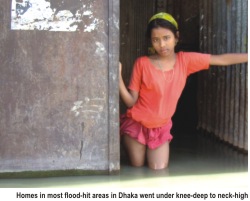 The
rivers around Dhaka such as Buriganga or Turag near Tongi
or Balu have been shrunk by encroachment to such an extent
that they now look more like hopeless canals than the mighty
rivers they used to be. Taking the advantage of the government's
inaction, unscrupulous businessmen and local goons, some enjoying
the support of the ruling party, have established houses or
business enterprises by encroaching into the river, shrinking
the width of the rivers alarmingly. Again by throwing huge
amounts of wastes from household garbage to tannery and other
industrial wastes we have made the rivers lose their natural
navigability to a great extent. Consequently the rivers can
no longer contain the volume of water they were originally
capable of, allowing water to flow over and drown their banks
during monsoons. "We must save our rivers from the encroachers
before they are choked to death; and there should be regular
dredging to keep these rivers navigable to stop them from
overflowing so easily," Bhuiyan emphasises. The
rivers around Dhaka such as Buriganga or Turag near Tongi
or Balu have been shrunk by encroachment to such an extent
that they now look more like hopeless canals than the mighty
rivers they used to be. Taking the advantage of the government's
inaction, unscrupulous businessmen and local goons, some enjoying
the support of the ruling party, have established houses or
business enterprises by encroaching into the river, shrinking
the width of the rivers alarmingly. Again by throwing huge
amounts of wastes from household garbage to tannery and other
industrial wastes we have made the rivers lose their natural
navigability to a great extent. Consequently the rivers can
no longer contain the volume of water they were originally
capable of, allowing water to flow over and drown their banks
during monsoons. "We must save our rivers from the encroachers
before they are choked to death; and there should be regular
dredging to keep these rivers navigable to stop them from
overflowing so easily," Bhuiyan emphasises.
 The
biggest blow as far as flood in Dhaka is concerned however,
comes from the unpardonable act of filling up of all sorts
of waterbodies across Dhaka. He lists some of the water bodies
in Dhaka that were grabbed and eaten up by the developers
in the last two decades. "There were canals in Dhaka
like the <>jheel in Motijheel, a canal in Dholaikhal,
another one in Narinda as well as the ones that are now Banosree
and Aftabnagar near Rampura, Baridhara and Basundhara in Gulshan.
Again water bodies in Badda, Baunia, Aminbazar, Meradia and
Hatirjheel were also indiscriminately filled up by land robbers.
After filling up everything inside Dhaka they have now set
their eyes on Dhaka's suburbs Ashulia, which is also slipping
away and the land near the Buriganga Bridge is being quickly
devoured by these hungry developers," he says. Next time
it will only be worse," he warns. The
biggest blow as far as flood in Dhaka is concerned however,
comes from the unpardonable act of filling up of all sorts
of waterbodies across Dhaka. He lists some of the water bodies
in Dhaka that were grabbed and eaten up by the developers
in the last two decades. "There were canals in Dhaka
like the <>jheel in Motijheel, a canal in Dholaikhal,
another one in Narinda as well as the ones that are now Banosree
and Aftabnagar near Rampura, Baridhara and Basundhara in Gulshan.
Again water bodies in Badda, Baunia, Aminbazar, Meradia and
Hatirjheel were also indiscriminately filled up by land robbers.
After filling up everything inside Dhaka they have now set
their eyes on Dhaka's suburbs Ashulia, which is also slipping
away and the land near the Buriganga Bridge is being quickly
devoured by these hungry developers," he says. Next time
it will only be worse," he warns.
 The
nexus between a section of political leadership and evil developers
has killed the many canals, lakes and other water bodies in
Dhaka for pure mercenary purposes. He then explains how they
do it: "Say, there is a canal and a particular developer
who wants to develop housing there, he buys the entire land
surrounding that canal and then simply devour that canal by
filling it with sand. Since such water bodies are usually
government property there is no one to stop them. Those responsible
for guarding them, like the influential people in the government
and a section of government officials, have already been bought
by these developers. The
nexus between a section of political leadership and evil developers
has killed the many canals, lakes and other water bodies in
Dhaka for pure mercenary purposes. He then explains how they
do it: "Say, there is a canal and a particular developer
who wants to develop housing there, he buys the entire land
surrounding that canal and then simply devour that canal by
filling it with sand. Since such water bodies are usually
government property there is no one to stop them. Those responsible
for guarding them, like the influential people in the government
and a section of government officials, have already been bought
by these developers.
And in this way Dhaka is now almost bereft
of any substandard waterbodies. "It is impossible to
recover those water bodies now, but we can at least guard
against any more of them getting filled up if we don't want
to see a fierce flood next time," he warns.
 Dhaka
has also been in need of protection by road-cum-dams like
the DND dam near Jatrabari, Sayedabad to Malibagh Biswaroad
or the circular one from Tongi to Sayedabad, without which
Dhaka would have been a couple of feet more under water. Specially
the proposed eastern by-pass road should be started immediately.
In fact a decision in that regard was taken some five to six
years back but nothing has been done yet," Bhuyian suggests.
This is once again the typical attitude of our government,
which, seems extremely concerned when there is a major flood
and promises to do everything to resist it in future, but
conveniently forgets when it comes to act upon their promises. Dhaka
has also been in need of protection by road-cum-dams like
the DND dam near Jatrabari, Sayedabad to Malibagh Biswaroad
or the circular one from Tongi to Sayedabad, without which
Dhaka would have been a couple of feet more under water. Specially
the proposed eastern by-pass road should be started immediately.
In fact a decision in that regard was taken some five to six
years back but nothing has been done yet," Bhuyian suggests.
This is once again the typical attitude of our government,
which, seems extremely concerned when there is a major flood
and promises to do everything to resist it in future, but
conveniently forgets when it comes to act upon their promises.
Again,
over the years, Dhaka has been turned into a concrete jungle.
There isn't any spot of soil or greenery to be found anywhere.
"Soil has a natural ability to absorb water but Dhaka,
wrapped up by concrete, is forcing the floodwater to stay
longer," he explains.
 When
there is When
there is
Little Relief
Bishawjit
Das
While
the government is adamant that they have adequate relief to
face the current flood disaster, thousands of flood-hit people
in and around the capital told The Daily Star correspondents
that relief is hard to come by and when it does arrive it
is either inadequate or substandard. The NGOs, individuals,
cultural and political organisations, are working along with
the government, to provide relief. But their actions are not
well co-ordinated or managed properly leading to further confusion.
Our correspondents have noticed that some people are getting
multiple relief in a day while many are deprived of food for
two/three days.
To
compound this miserable scenario drinking water has become
increasingly scarce in many of the flood-hit areas in and
around the capital. The situation demands an urgent supply
of water purifying tablets and medicines for water-borne diseases.
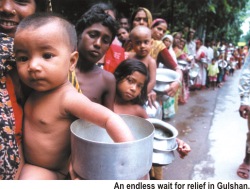 On
July 31hundreds of people in more than 30 villages along the
Balu and Turag rivers in Dhaka and Narayanganj were found
waiting in front of their inundated houses with jugs, pitchers
and other containers to collect drinking water from relief
workers. On
July 31hundreds of people in more than 30 villages along the
Balu and Turag rivers in Dhaka and Narayanganj were found
waiting in front of their inundated houses with jugs, pitchers
and other containers to collect drinking water from relief
workers.
"Why
do they (relief workers) bring drinking water for us?"
asked housewife Yasmin of the area. "Give us water purifying
tablets and medicines for the diseases we are exposed to,"
she urged.
In
Bachhila and Owajpur areas in Mohammadpur, around 3000 families
had been living in under floodwaters for last 23 days. Residents
of hundreds of houses had deserted the inundated area or sent
their children away due to lack of relief, mostly because
there just wasn't any safe water to drink.
"We
have had no choice but to drink the river water since all
the tube-wells in the village are under water," said
Sajol, a local of Bachhila. "We do not have any supply
of contamination-free water from outsides, we are mixing alum
with water and drinking it for the last couple of days,"
he added.
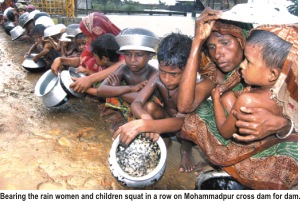 Close
to Dhaka, Manikganj is also in acute crisis, affecting around
10 lakh flood-hit people. Many of them are suffering from
water-borne diseases. Again, inadequate relief and contaminated
food and drinking water are blamed for such unnecessary suffering. Close
to Dhaka, Manikganj is also in acute crisis, affecting around
10 lakh flood-hit people. Many of them are suffering from
water-borne diseases. Again, inadequate relief and contaminated
food and drinking water are blamed for such unnecessary suffering.
A
visit to three relief distribution centres on July 28 revealed
that hundreds of people were not receiving any relief.
At
Jagir High School relief distribution centre in Manikganj
municipality, some 500 people were anxiously waiting for more
than two hours for the local lawmaker, who, after his arrival,
scolded the local administration finding inadequate relief
he allocated. In anger he blamed the concerned authority yelling,
"Where has the relief gone? Do you think relief comes
from your father's possession?"
"The
relief centre provides khichuri once a day and that
is what we eat here ," said primary school student Rupali,
who had been waiting for relief distribution along with 200
women and children who have taken shelter at a school.
 "I
have been living at Aricha Belayet Hossain High School flood
shelter for the last eight days along with 100 other flood-hit
people, but I have received no relief till now," said
Maleka Begum, secretary of Shibalaya upazila Mohila BNP unit. "I
have been living at Aricha Belayet Hossain High School flood
shelter for the last eight days along with 100 other flood-hit
people, but I have received no relief till now," said
Maleka Begum, secretary of Shibalaya upazila Mohila BNP unit.
A
number of women including Saleha, Anwara and Momtaj of Shibalaya
and Hazera, Kabila, Mariam Rizina and Lucky of Manikganj municipality
wanted their names to be put on the food distributing list.
"Sir,
take my name," uttered Momtaj in a feeble voice, adding,
"I have been starving for the last two days."
There
were also people like Nessa Banu, a 65-year-old woman from
Falsatia, who complained of receiving rotten rice in the relief
packet on Saturday morning.
At
Barangail village, she showed The Daily Star correspondent
a packet containing two kg of rice, potato and onion that
were rotten. "It is better to starve than take this sort
of relief," she said.
Police
had intercepted several political and cultural organisations
from collecting relief and fund-raising programmes in the
capital, though the government had urged people of all quarters
to take initiatives since the beginning of the flood.
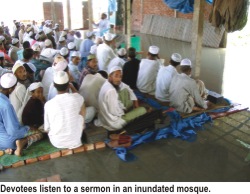 Many
non-government organisations and individuals are operating
relief programmes in the flood-prone areas. Many individuals
have taken up feeding programmes to the flood affected in
the Gulshan, Banani and Baridhara areas. Many
non-government organisations and individuals are operating
relief programmes in the flood-prone areas. Many individuals
have taken up feeding programmes to the flood affected in
the Gulshan, Banani and Baridhara areas.
Finding
no place at government flood shelters and no food brought
in by relief workers many have taken refuge in nearby houses
still safe from floods, where members offer to share their
home and food.
"We
help ourselves," boasted 50-year-old Faiz Uddin of Balitha
village. " A flood-hit family is in my house along with
their belongings and they will stay as long as my house is
not inundated." He went on, "We share our food with
them at this time of gajab (deluge ) and I believe
we can overcome the problem this way."
Copyright
(R) thedailystar.net 2004
| 